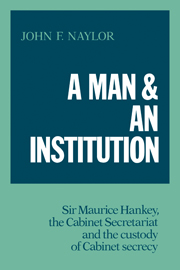 A Man and an Institution
A Man and an Institution Book contents
1 - The origins of the Cabinet Secretariat
Published online by Cambridge University Press: 30 March 2010
Summary
As the debacle at the Somme ground to a halt in the chilling autumn rains and the squalid muck of the battlefield, the Allied leaders gathered in Paris, in mid-November 1916, to assess the military situation. Two men who shared growing doubts about the British role in the war took a ‘stroll’ before a morning session of the conference, exchanging views about their country's contribution. One of them was the well-known and controversial politician, David Lloyd George; the other, hardly a public figure, was Lieut Col. Maurice Hankey, a leading military adviser to the government who had served as Secretary to the pre-war Committee of Imperial Defence and during the war as Secretary to the three committees which had, in turn, worked with questions of military policy for the Cabinet. Although a recent appointee as Secretary of State for War, Lloyd George had already become frustrated with the deference consistently shown to the military views voiced by the Imperial General Staff and the British Expeditionary Force exhibited by Prime Minister Asquith, head of a Coalition government.
According to Lloyd George's recollection, Hankey took the initiative and sketched proposals for a re-organization of the British war effort:
We both felt that nothing in the way of a change in the conduct of the war had been accomplished and that in the absence of some dramatic coup things would go on as before until we slide into inevitable catastrophe … I was in favour of an immediate resignation [on his own part]. […]
- Type
- Chapter
- Information
- A Man and an InstitutionSir Maurice Hankey, the Cabinet Secretariat and the Custody of Cabinet Secrecy, pp. 8 - 48Publisher: Cambridge University PressPrint publication year: 1984
- 2
- Cited by


